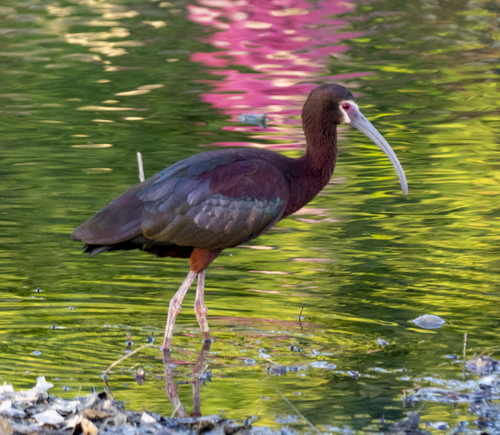
White-faced Ibis
The White-faced Ibis (*Plegadis chihi*) is a wading bird known for its distinctive white facial feathers that contrast with its rich, iridescent plumage. It plays a crucial role in wetland ecosystems, helping to control populations of insects, crustaceans, and small vertebrates. This species is not typically associated with strong cultural significance but is highly valued by birdwatchers and nature enthusiasts for its beauty and graceful movements. It has a broad distribution across the Americas, showcasing its adaptability to various wetland habitats.
46-56 cm
Length
80-90 cm
Wingspan
Least Concern
Conservation Status
Distribution
The White-faced Ibis is found from the western United States through Mexico and Central America, with significant populations in South America, particularly in Argentina, Chile, and Brazil. They exhibit migratory behavior, with northern populations moving south for the winter. They are found at elevations up to, and sometimes exceeding, 2500m.
Lifespan
Up to 14 years recorded in the wild, though average lifespan is likely shorter.
White-faced Ibis's Habitat
Habitat Types
Freshwater marshes, Shallow lakes, Wet meadows, Flooded agricultural fields, Estuaries
Climate Zones
Temperate, Subtropical, Tropical
Adaptations
Their long legs and bill are perfectly adapted for wading in shallow water and probing mud for prey. Their slightly webbed feet provide stability on soft substrates.
Variations
While generally considered monotypic (no subspecies), some regional variations in size and plumage intensity have been observed, but are not formally recognized as distinct subspecies.
Appearance
Breeding Plumage
Breeding plumage is characterized by rich chestnut body feathers with iridescent green and purple gloss. Non-breeding plumage is duller, with less pronounced iridescence. The white facial feathers are present year-round, but more prominent during breeding.
Seasonal Feather Changes
The most significant change is the intensity of iridescence and the bare facial skin, which becomes brighter red during breeding season.
Sex Based Plumage Differences
Minimal; males may have slightly brighter plumage during breeding season.
Notable Features
White ring of feathers around the face, Long, decurved bill, Reddish legs and facial skin (brighter during breeding)
Diet and Feeding
Primary Foods
Insects, Crustaceans, Small fish, Snails, Worms, Amphibians, Occasionally plant material
Foraging Behavior
White-faced Ibises typically forage by wading in shallow water and probing the mud with their long bills. They may also forage in wet fields or grasslands, picking prey from the surface.
Specializations
Their decurved bill is specialized for probing soft substrates to extract invertebrates.
Seasonal Diet Variations
Diet may shift slightly depending on prey availability. For example, they may consume more insects during the breeding season when insect populations are high.
Behavior
Social Structure
Highly social, often found in flocks, particularly during the non-breeding season. They breed in colonies, sometimes with other wading bird species.
Communication
Guttural croaks and grunts, Bill snapping during courtship, Visual displays, such as bowing and preening
Migration
Many populations are migratory, moving to warmer climates for the winter. Migration routes can vary widely depending on the breeding location.
Territorial or Group Behaviors
Within breeding colonies, pairs defend a small territory around their nest. Outside of the breeding season, they are generally non-territorial.
Conservation
Threats
Habitat loss and degradation (wetland drainage), Pesticide contamination, Human disturbance at nesting colonies, Water pollution
Protection Programs
Wetland conservation and restoration initiatives, Monitoring of pesticide levels in ibis habitats, Protection of nesting colonies from disturbance
Local National Laws
Protected under the Migratory Bird Treaty Act in the United States. Various state and local laws also offer protection.
Population Trend
Stable
Population Estimates
The global population is estimated to be around 1.2 million individuals.
Interesting Facts
They often fly in V-formations, like geese.
This flight pattern reduces wind resistance and conserves energy during long flights.
Their scientific name, *Plegadis chihi*, is derived from the Greek word 'plegados' (sickle, referring to the bill shape) and 'chihi', an onomatopoeic name mimicking its call.
This highlights both a physical characteristic and a vocalization of the species.
White-faced Ibises can form large breeding colonies, sometimes numbering thousands of pairs.
This colonial nesting behavior provides safety in numbers from predators.
Faqs about White-faced Ibis
What is the difference between a White-faced Ibis and a Glossy Ibis?
The White-faced Ibis has a distinct white ring of feathers around its face, which the Glossy Ibis lacks. Glossy Ibises also tend to have darker, more uniformly colored facial skin.
Where can I see White-faced Ibises?
Look for them in wetlands, marshes, and flooded agricultural fields within their geographic range. Check local birdwatching guides or online resources for specific locations.
Are White-faced Ibises endangered?
No, they are currently classified as Least Concern by the IUCN. However, they are still vulnerable to habitat loss and other threats.
Copyright @ Nature Style Limited. All Rights Reserved.
 English
English